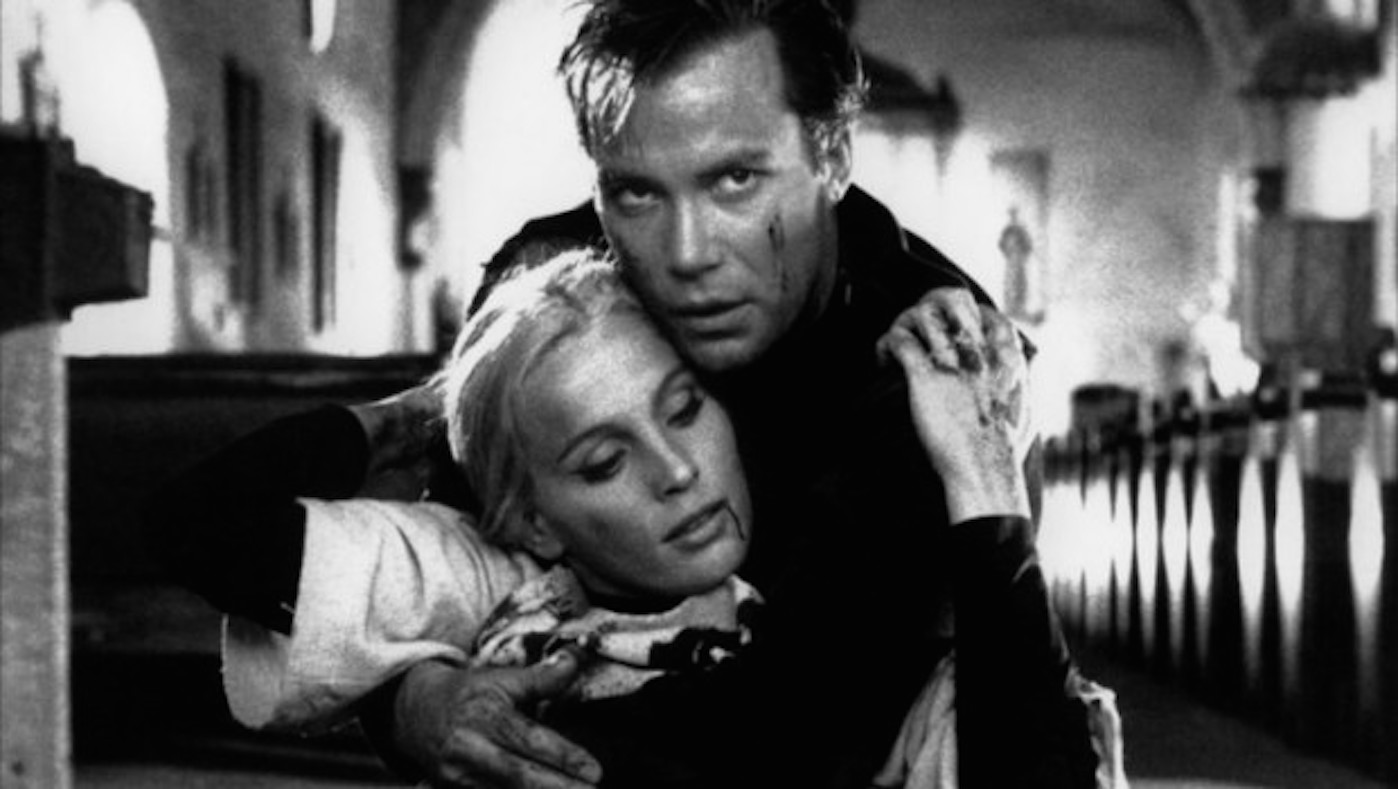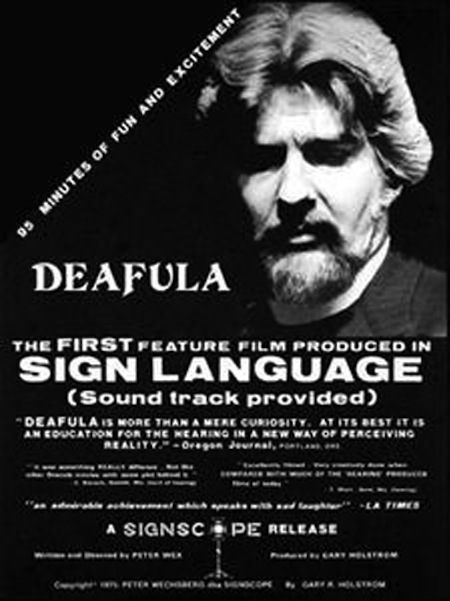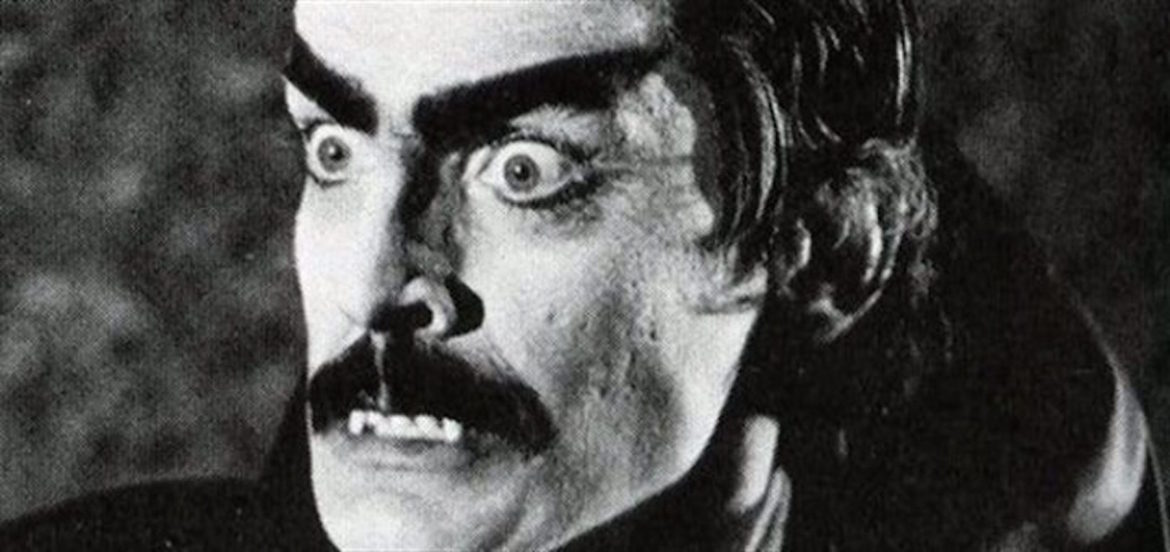The history of cinema is replete with movie gimmicks. Look at A Quiet Place, which terrifies audience with barely any dialogue. But I love the more ambitious crackpot ones like Smell-o-vision, developed by Liz Taylor’s stepson Mike Todd Jr. for The Scent Of Mystery (1960). During the course of the movie aromas were pumped through the air-conditioning system, transforming the theater into a nauseating smelly wonderland. Or “Psychorama”, which supposedly introduced subliminal messages into a film by flashing images on the screen so quickly they couldn’t be recognized by the conscious mind (like the frames of snakes, skulls and the letters B-L-O-O-D) injected into My World Dies Screaming (1958) aka Terror In The Haunted House. And don’t get me started on master showman William Castle.
But two of my favorite lesser known gimmick films have to be Incubus, an artsy supernatural thriller starring William Shatner that was filmed in Esperanto, and Deafula, the only known sign-language vampire movie.

Incubus (1966) was the brainchild of Daystar Productions, which also made the memorable 60’s sci-fi TV series The Outer Limits. After its cancellation, the company, on the verge of bankruptcy, turned to director Leslie Stevens to make a small independent horror film. Stevens was fascinated with Esperanto, the international second language created in 1887 by Polish occultist Ludwig L. Zamenhof, an experiment that never caught on and was even publically derided by Joseph McCarthy, Stalin and Hitler. Why Stevens thought an entire movie spoken in this ludicrous language- which sounds like a cross between Serbian, Swedish, Spanish and Latin- would be a financial gold mine is anyone’s guess. He hired his girlfriend Allyson Ames, and an intense young actor named William Shatner (still a year away from Star Trek), as well as expert cinematographer Conrad Hall. They headed for California’s Big Sur to film Steven’s supernatural vision.

Supposedly set in the ancient seaside village of Nomen Tuum- “a place of dark miracles…a searching ground for demons, manifesting themselves as young women”- Incubus features Ames as a fiendish succubus named Kia, who lures “corrupted” men to their death. At the film’s beginning, she entices a drunkard to the sea and drowns him by holding his head underwater with her foot. Bored, she decides it would be fun to corrupt a “pure” soul, setting her sights on pious, God-fearing Marc (Shatner), who lives with his virginal sister, Arndis (Ann Atmar). Kia tempts Marc to “lie down naked in the sun by the sea,” while his sister goes blind by looking at an eclipse and wanders aimlessly through the forest. When Marc carries Kia into a church, her eldest sister, Amael, is incensed that she has been “defiled by the act of love” and calls up a dark, sweaty incubus from the ground (Milos Milos) who proceeds to rape Marc’s blind sister in retribution. The finale features a fight between good and evil outside a Spanish mission with Shatner, bleeding and over-acting, battling the incubus, who has transformed into a giant goat. Fino (which means “the end” in Esperanto).
Visually, Incubus is reminiscent of Ingmar Bergman’s The Virgin Spring, but few in this country have ever gotten a chance to see it, as the film was plagued by disaster. When it was screened at the 1966 San Francisco Film Festival, the print lacked sound. No matter. The dialogue, which the cast speaks phonetically, appalled Esperanto speakers with its many mispronunciations. Milos Milos, who’d been having an affair with Mickey Rooney’s wife, murdered her, then killed himself. Ann Atmar committed suicide shortly after the film was completed. Incubus was, however, a smash in France, and the only two surviving prints surfaced a while back in the permanent collection of the Cinematheque Francaise.

Deafula (1975) Was created in Sign-Scope for deaf and hard-of-hearing audiences by writer-director Peter Wechsberg, the first deaf man to broadcast TV news in sign language. Dudley Hemstreet stars as a bumbling, pipe-smoking detective brought to America from Scotland Yard to assist the police in several mysterious unsolved murders. The culprit ironically turns out to be the lead cop’s best friend, Steve Adams (Wechsberg), the personable, peanut-loving son of a preacher. Steve is haunted by memories of being a happy, fun-loving child who also drank the blood of his puppy. But as an adult he unknowingly transforms into a vampire, complete with black hair, a cape, fake fangs and a big nose. When Steve tries to uncover the secret of his real ancestry, he tracks down the woman who assisted with his mother’s birth. She reveals that Steve’s real dad is Dracula, currently residing in a coffin in a nearby cave. Depressed, Steve hunts him down and introduces himself. “I am your son, Deafula,” he says, before driving a stake through his heart. The finale takes place in a church with Steve giving an impassioned, endless hand-wringing soliloquy to God before collapsing dead on the altar. Filmed in black and white at the height of the hippie era (everyone has long hair and sideburns). Deafula contains long stretches of silence followed by voice-overs as the cast let their hands do the talking. Weird and wonderful, both films really remind you of the limitless- and idiotic- possibilities of cinema.


